
Ichthyosauria is an order of large extinct marine reptiles sometimes referred to as "ichthyosaurs", although the term is also used for wider clades in which the order resides.

Ichthyopterygia was a designation introduced by Sir Richard Owen in 1840 to designate the Jurassic ichthyosaurs that were known at the time, but the term is now used more often for both true Ichthyosauria and their more primitive early and middle Triassic ancestors.
Tumbler Ridge is a district municipality in the foothills of the B.C. Rockies in northeastern British Columbia, Canada, and a member municipality of the Peace River Regional District. With a population of 2,399 (2021) living in a townsite, the municipality encompasses an area of 1,558 km2 (602 sq mi) of mostly Crown land. The townsite is located near the confluence of the Murray River and Flatbed Creek and the intersection of Highway 52 and Highway 29 and includes the site of the Tumbler Ridge Secondary School and Tumbler Ridge Airport. It is part of the Peace River South provincial electoral district and the Prince George—Peace River—Northern Rockies federal riding.
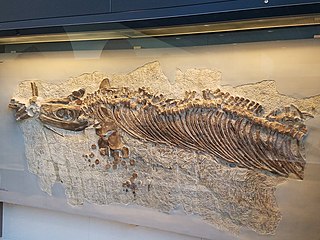
Cymbospondylus is an extinct genus of large ichthyosaurs, of which it is among the oldest representatives, that lived during the Anisian stage of the Middle Triassic in what are now North America and Europe. The first known fossils of this taxon are a set of more or less complete vertebrae which were discovered in the 19th century in various mountain ranges of Nevada, in the United States, before being named and described by Joseph Leidy in 1868. It is in the beginning of the 20th century that more complete fossils were discovered through several expeditions launched by the University of California, and described in more detail by John Campbell Merriam in 1908, thus visualizing the overall anatomy of the animal. While many species have been assigned to the genus, only five are recognized as valid, the others being considered synonymous, doubtful or belonging to other genera. Cymbospondylus was formerly classified as a representative of the Shastasauridae, but more recent studies consider it to be more basal, view as the type genus of the Cymbospondylidae.

Claudiosaurus is an extinct genus of diapsid reptiles from the Late Permian Sakamena Formation of the Morondava Basin, Madagascar. It has been suggested to be semi-aquatic.

Utatsusaurus hataii is the earliest-known ichthyopterygian which lived in the Early Triassic period. It was nearly 2.5–3 metres (8.2–9.8 ft) long with a slender body. The first specimen was found in Utatsu-cho, Miyagi Prefecture, Japan. It is the only described species in the genus Utatsusaurus and the only member of the family Utatsusauridae. The name Utatsusaurus was given after the city. The fossils have been found from the Early Triassic Osawa Formation of Miyagi Prefecture, Japan and British Columbia, Canada.
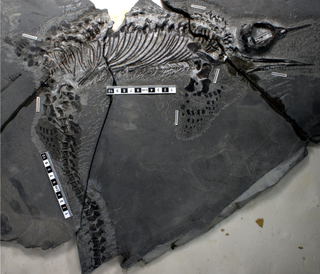
Chaohusaurus is an extinct genus of basal ichthyopterygian, depending on definition possibly ichthyosaur, from the Early Triassic of Chaohu and Yuanan, China.

Omphalosaurus is an extinct genus of marine reptile from the Early Triassic to Middle Triassic, thought to be in the order of Ichthyosauria. Most of what is known about Omphalosaurus is based on multiple jaw fragments, ribs, and vertebrae. Specimens of Omphalosaurus have been described from the western United States, Poland, Austria and the island of Spitsbergen off the northern coast of Norway.
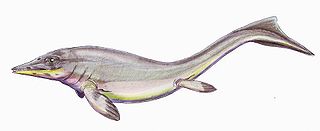
Grippia is a genus of early ichthyopterygian, an extinct group of reptiles that resembled dolphins. Its only species is Grippia longirostris. It was a relatively small ichthyopterygian, measuring around 1–1.5 metres (3.3–4.9 ft) long. Fossil remains from Svalbard from the specimen SVT 203 were originally assigned to G. longirostris but are now thought to have belonged to a non-ichthyopterygian diapsid related to Helveticosaurus.

Helveticosaurus is an extinct genus of diapsid marine reptile known from the Middle Triassic of southern Switzerland. It contains a single species, Helveticosaurus zollingeri, known from the nearly complete holotype T 4352 collected at Cava Tre Fontane of Monte San Giorgio, an area well known for its rich record of marine life during the Middle Triassic.
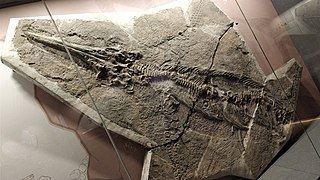
Guizhouichthyosaurus is an extinct genus of ichthyosaur which is known primarily from the Xiaowa Formation of the lower Carnian stage of the Late Triassic in southwest China. The type species of this genus is Guizhouichthyosaurus tangae, of which multiple skeletons are known. It has been reassigned as a species of the genus Shastasaurus in the past, though it has since been considered distinct. The ichthyosaurs Cymbospondylus asiaticus, named in 2002, and Panjiangsaurus epicharis, named in 2003, are junior synonyms of G. tangae. The genus is also known from the Ladinian-aged Middle Triassic Zhuganpo Formation; additionally, the species "Callawayia" wollongangense may belong to Guizhouichthyosaurus.
Parvinatator, from Latin, “parvus” little and “natator” swimmer, is an extinct genus of small ichthyopterygian marine reptile that lived during the Early to Middle Triassic. Its fossils have been found in British Columbia, Canada.
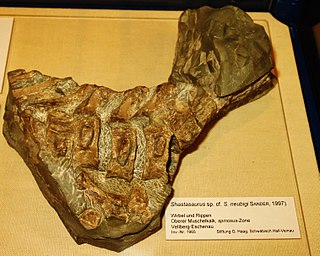
Phantomosaurus is an extinct genus of ichthyosaur that lived during the late Anisian stage of the Middle Triassic. Fossils have been found in southern Germany. It was discovered in 1965 and named in 1997 as a species of Shastasaurus by Sander in the rocks of the Upper Muschelkalk.

Thaisaurus is an extinct genus of ichthyopterygian marine reptile that lived during the Spathian. Fossils have been found in Thailand.
Mixosauridae was an early group of ichthyosaurs, living between 247.2 and 235 million years ago, during the Triassic period. Fossils of mixosaurs have been found all over the world: China, Timor, Indonesia, Italy, Germany, Spitsbergen, Switzerland, Svalbard, Canada, Alaska, and Nevada.

Thalattoarchon is a genus of large, Middle Triassic predatory ichthyosaur from North America, containing the single species T. saurophagis. The taxon was described in 2013 from a single specimen discovered in the Favret Formation in Nevada. The generic name, meaning "ruler of the seas", refers to its status as an apex predator, while the specific epithet, meaning "lizard eater", alludes to its carnivorous diet. The classification of this genus within the ichthyosaurs is much debated, being either classified within the clade Merriamosauria or in the more basal family Cymbospondylidae.
The Sulphur Mountain Formation is a geologic formation of Early to Middle Triassic age. It is present on the western edge of the Western Canada Sedimentary Basin in the foothills and Rocky Mountains of western Alberta and northeastern British Columbia. It includes marine fossils from the time shortly after the Permian-Triassic extinction event.
The Vikinghøgda Formation is a geologic formation in Svalbard, Norway. It preserves fossils dating back to the Early Triassic (Griesbachian-Spathian) period. It is split into three members, from oldest to youngest: the Deltadalen Member (Induan), Lusitaniadalen Member (Smithian), and Vendomdalen Member (Spathian). The formation can be found in central Spitsbergen, southern Spitsbergen, as well as the smaller islands of Barentsøya and Edgeøya. The type locality is positioned in the vicinity of Vikinghøgda and Sticky Keep, two low peaks along the southeast edge of Sassendalen in Spitsbergen. The two upper members of the Vikinghøgda Formation were previously grouped together as the Sticky Keep Formation.

This timeline of ichthyosaur research is a chronological listing of events in the history of paleontology focused on the ichthyosauromorphs, a group of secondarily aquatic marine reptiles whose later members superficially resembled dolphins, sharks, or swordfish. Scientists have documented ichthyosaur fossils at least as far back as the late 17th century. At that time, a scholar named Edward Lhuyd published a book on British fossils that misattributed some ichthyosaur vertebrae to actual fishes; their true nature was not recognized until the 19th century. In 1811, a boy named Joseph Anning discovered the first ichthyosaur fossils that would come to be scientifically recognized as such. His sister Mary would later find the rest of its skeleton and would go on to become a respected fossil collector and paleontologist in her own right.





















